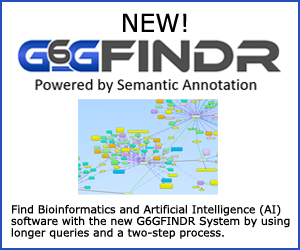microRNA and mRNA integrated analysis (MMIA)
Category Genomics>Gene Expression Analysis/Profiling/Tools
Abstract MMIA is a versatile and user-friendly web server that can be used to improve and facilitate research of miRNA functions and regulation.
MicroRNAs (miRNAs) are small (19-22 nucleotide) non-protein-coding RNA molecules that function to regulate the expression of specific ‘target’ gene products via hybridization to mRNA transcripts, in concert with associated ribonucleoprotein complexes, to effect translational blockade or message degradation.
Although miRNAs have been implicated in numerous developmental and adult disease states, including cancer, their impact on distinct biological pathways and cellular phenotypes, in addition to miRNA gene promoter regulation, remains largely unknown.
MMIA provides life science researchers with a valuable tool for the study of the biological (and pathological) causes and effects of the expression of this class of interesting protein regulators.
By incorporating three (3) commonly used and accurate miRNA 'prediction algorithms', TargetScan, PITA and PicTar (see below...);
MMIA integrates miRNA and mRNA expression data with predicted miRNA target information for analyzing miRNA-associated phenotypes and biological functions by Gene Set Enrichment Analysis (GSEA), in addition to the analysis of miRNA primary transcript gene promoters.
To assign biological relevance to the integrated microRNA/mRNA profiles, MMIA uses exhaustive human genome coverage (5,782 gene sets), including various disease-associated genes as well as conventional canonical pathways and Gene Ontology (GO).
This novel web server provides users with miRNA-mRNA expression data combined analysis tools and broad gene sets.
Combined analysis of miRNA and mRNA --
The MMIA web-server is a novel approach for integrating miRNA and mRNA expression data, based on the manufacturer's recent study -
(Xin F, Li M, Balch C, Thomson M, Fan M, Liu Y, Hammond SM, Kim S, Nephew KP. Computational analysis of miRNA profiles and their target genes suggests significant involvement in breast cancer anti-estrogen resistance. Bioinformatics (2009) 25:430–434).
Although the precise mechanism(s) by which miRNAs induce mRNA degradation and regulate protein expression by post-transcriptional silencing have Not been fully elucidated, perfect miRNA seed:target complementarity is predominantly associated with target gene destabilization.
Thus, MMIA compares inverse expression of mRNAs and miRNAs (e.g. up- regulated miRNAs and down-regulation of their predicted target mRNAs).
MMIA Input --
The expression microRNA and mRNA data input for MMIA is a simple tab-delimited data format, followed by two (2) header lines for class and sample descriptions.
To provide further versatility, the user can also enter a regulated microRNA list in the microRNA input field.
Expression microarray annotations supported by the server include Ensemble, the National Center for Biotechnology Information (NCBI) RefSeq and Entrez Gene, Swiss-Prot, and Affymetrix probe-sets.
MMIA Output --
The output shows Not only significantly differentially expressed microRNAs and their predicted mRNA target information but also miRNA-mRNA expression combined pathway analysis based on GSEA, as performed for the predefined gene sets in terms of statistically differentially expressed mRNA predicted targets by multiple up/down regulated microRNA genes.
The manufacturer's major ‘gene set’ is derived from the following three (3) universally used sources:
1) Kyoto Encyclopedia of Genes and Genomes (KEGG);
2) MIT MSigDB - [The Molecular Signatures Database (MSigDB) is a collection of gene sets for use with GSEA software]; and
3) G2D - [The Genes2Diseases (G2D) server presents pre-computed candidate genes for more than 600 genetically inherited diseases that have been mapped onto chromosomal regions without assignment of a particular gene] - (see G6G Abstract Number 20426) - providing information such as biological pathway, cancer-related genes, Gene Ontology (GO), and inherited diseases.
Additional novel features of the MMIA include microRNA gene promoter (in annotated primary miRNA (pri-miRNA) regions) analysis for conserved transcription factor binding sites and a disease-related microRNA database -
miR2Disease - (miR2Disease is a manually curated database that aims at providing a comprehensive resource of miRNA deregulation in various human diseases).
MMIA target prediction algorithms --
MMIA uses three (3) miRNA target prediction algorithms -
1) TargetScan - (Lewis BP, Burge CB, Bartel DP. Conserved seed pairing, often flanked by adenosines, indicates that thousands of human genes are miRNA targets. Cell (2005) 120:15–20);
2) PicTar (PicTar 4 species conservation, PicTar 5 species conservation) - (Krek A, Grun D, Poy MN, Wolf R, Rosenberg L, Epstein EJ, MacMenamin P, da Piedade I, Gunsalus KC, Stoffel M, et al. Combinatorial miRNA target predictions. Nat. Genet. (2005) 37:495– 500); and
3) PITA (probability of interaction by target accessibility) - (Kertesz M, Iovino N, Unnerstall U, Gaul U, Segal E. The role of site accessibility in miRNA target recognition. Nat. Genet. (2007) 39:1278–1284) that require stringent miRNA seed:target complementarity (thus favoring mRNA transcript degradation).
Using the MMIA tool --
Using the MMIA tool is quite straightforward, starting with the manufacturers input web page, which is composed of four (4) mandatory steps and a fifth optional step, in MMIA.
For steps 1) and 3) of the web page, users upload miRNA and mRNA expression data, respectively.
In Step 1) - the user submits a miRNA gene list and is also prompted to select either up- or down-regulated miRNAs for data analysis.
Step 2) - provides Not only selection of the desired miRNA target prediction algorithm (TargetScan, PicTar or PITA) (see above...) but also allows a combinatorial analysis, based on the intersection of two (2) of the algorithms.
Step 4) - of the web page allows users to select 'gene sets' for GSA (Gene Set Analysis) analysis, based on the manufacturers recently described method (see Combined analysis of miRNA and mRNA above...).
Step 5) - provides optional analyses of examining enriched transcription factor binding sites within miRNA primary transcript promoter regions, disease associations, and an alternative miRNA-mRNA combined analysis, using MIT GSEA software (see G6G Abstract Number 20266).
System Requirements
Web-based.
Manufacturer
- Medical Sciences Program
- Indiana University
- Bloomington, IN 47405
- USA
Manufacturer Web Site MMIA
Price Contact manufacturer.
G6G Abstract Number 20491
G6G Manufacturer Number 104113







